The Golf Cart Batteries Market is estimated to be valued at USD 158.0 billion in 2025 and is projected to reach USD 267.3 billion by 2035, registering a compound annual growth rate (CAGR) of 5.4% over the forecast period.
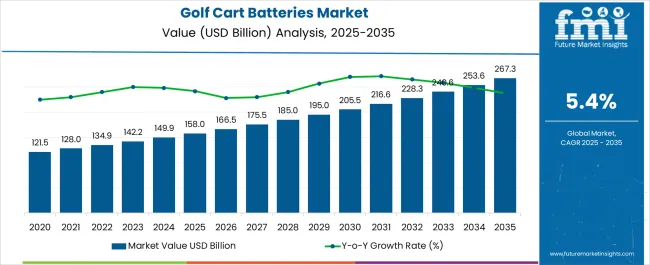
| Metric | Value |
|---|---|
| Golf Cart Batteries Market Estimated Value in (2025 E) | USD 158.0 billion |
| Golf Cart Batteries Market Forecast Value in (2035 F) | USD 267.3 billion |
| Forecast CAGR (2025 to 2035) | 5.4% |
The Golf Cart Batteries market is experiencing robust growth, driven by the increasing adoption of electric golf carts in residential communities, resorts, and recreational facilities. The shift towards environmentally friendly mobility solutions, coupled with growing awareness of carbon emission reduction, is accelerating the demand for high-performance battery systems. In addition, ongoing technological advancements in battery chemistry, energy density, and lifecycle management are shaping the future outlook of the market.
Increasing investments in electric mobility infrastructure, coupled with incentives for clean energy adoption, are supporting market expansion. The growing emphasis on low-maintenance and long-lasting energy storage solutions is influencing buyer preferences, particularly among commercial and recreational operators.
Furthermore, the rising penetration of electric drive systems in golf carts, which require optimized energy management and reliable voltage supply, is creating opportunities for battery manufacturers to provide advanced solutions that improve operational efficiency As urban and semi-urban leisure developments expand globally, the Golf Cart Batteries market is expected to sustain a positive growth trajectory, with a focus on performance, reliability, and eco-conscious mobility solutions.
The golf cart batteries market is segmented by battery type, drive type, battery voltage, seating capacity, and geographic regions. By battery type, golf cart batteries market is divided into Lead-Acid Batteries and Li-Ion Batteries. In terms of drive type, golf cart batteries market is classified into 36V Electric Drive and 48V Electric Drive. Based on battery voltage, golf cart batteries market is segmented into 12 Volts, 6 Volts, and 8 Volts. By seating capacity, golf cart batteries market is segmented into 2 – 4 Seater, 6 – 8 Seater, and 10+ Seater. Regionally, the golf cart batteries industry is classified into North America, Latin America, Western Europe, Eastern Europe, Balkan & Baltic Countries, Russia & Belarus, Central Asia, East Asia, South Asia & Pacific, and the Middle East & Africa.
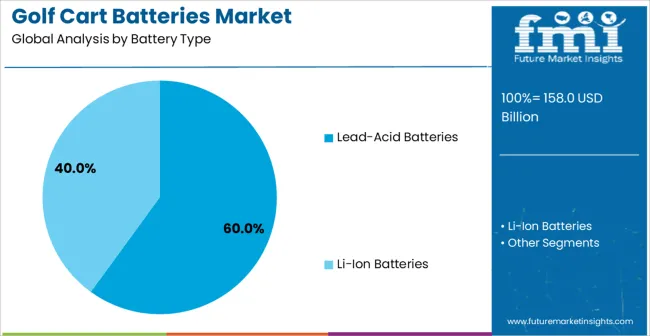
The Lead-Acid Batteries type is projected to hold 60.00% of the Golf Cart Batteries market revenue share in 2025, establishing it as the dominant battery chemistry. This leading position is attributed to its proven reliability, cost-effectiveness, and ease of maintenance compared to alternative battery types. Lead-acid batteries are favored in both recreational and commercial golf cart fleets due to their ability to deliver stable power output and withstand frequent charge-discharge cycles.
Their wide availability and established supply chains have facilitated quick adoption across multiple regions. The segment has benefited from ongoing improvements in design and durability, which extend battery life and enhance energy efficiency.
Additionally, the familiarity of end-users with lead-acid battery management practices has reduced operational risks and maintenance costs As the demand for durable and affordable electric mobility solutions continues to rise, lead-acid batteries are expected to retain their market leadership, supported by their compatibility with existing electric drive systems and proven performance in diverse operational conditions.
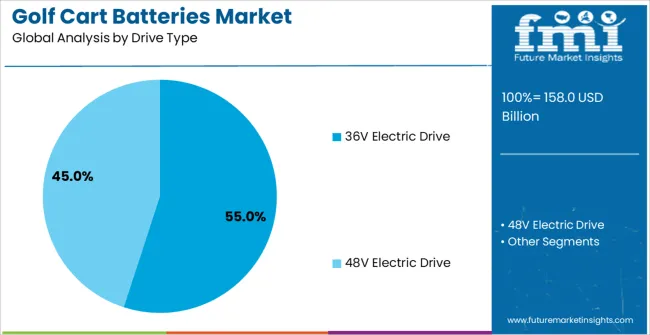
The 36V Electric Drive type is anticipated to capture 55.00% of the Golf Cart Batteries market revenue share in 2025, making it the leading drive voltage configuration. Its dominance is being driven by compatibility with the majority of commercial and recreational golf carts, which require a balance between power output and energy efficiency.
This segment has been favored because it enables sufficient torque and speed for varied terrains while maintaining longer battery runtime, which is critical for uninterrupted operation in golf courses and resorts. The growth of this segment is further supported by the standardization of 36V electric drive systems across the industry, which allows manufacturers to design batteries and controllers that are widely interoperable.
Additionally, the ease of maintenance, proven reliability, and cost-effectiveness associated with 36V systems have reinforced adoption With increasing emphasis on operational efficiency and performance consistency, the 36V Electric Drive segment is expected to continue leading the market and driving demand for optimized battery solutions.
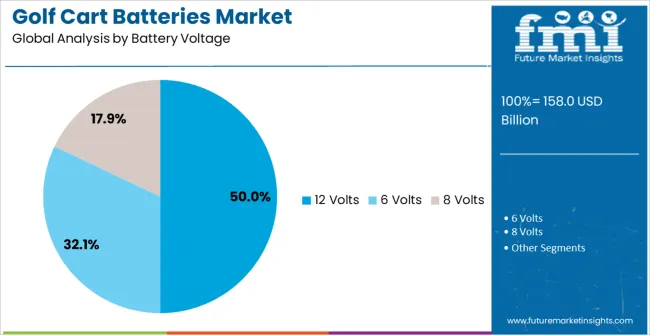
The 12 Volts battery configuration is expected to hold 50.00% of the Golf Cart Batteries market revenue share in 2025, positioning it as the dominant voltage rating. This leading share is attributed to its compatibility with a broad range of golf cart models, enabling scalable series connections to achieve required system voltages. The 12 Volts configuration is preferred due to its reliability, ease of replacement, and compatibility with standard charging infrastructure.
Its widespread adoption has been accelerated by the balance it provides between safety, performance, and cost-effectiveness, making it suitable for both commercial and recreational applications. Operational advantages, including predictable discharge characteristics and low maintenance requirements, have reinforced its adoption in fleet management and high-utilization environments.
Furthermore, the 12 Volts segment supports modular battery system designs, allowing end-users to upgrade or replace cells without significant system downtime As golf cart applications continue to expand globally, this voltage configuration is anticipated to remain the most preferred choice, sustaining the segment’s market leadership and influencing the design of future battery solutions.
Golf carts are generally battery-operated vehicles, simple in construction and have maximum speed of up to 31 Kmph, making golf carts safe and favorable vehicles to be used at public places such as railway stations, airports and tourist spots apart from golf courses.
Further, golf carts are easy to operate and do not require trained people to operate them. Leniency in government regulations, coupled with simplicity in manufacture of golf carts, has boosted production of golf carts as well as golf cart batteries across the globe.
Since, the battery is playing key role of power source in the electric golf cart like fuel in conventional vehicle. So, the type battery used in the golf cart is the matter of serious concern. As the range of the golf cart is totally dependent on the type of battery used.
In the current scenario of golf cart batteries market, lead acid batteries are holding dominating shares. Moreover, it is expected that the demand for golf cart batteries is significant shifting towards li-ion batteries and it is anticipated to remain most attractive segment in the global market throughout the forecast period.
The higher advantages offered by li-ion batteries such as long battery life, higher load carrying capacity, long distance can be covered and relatively small in size are driving the li-ion battery demand in the global golf cart batteries market.
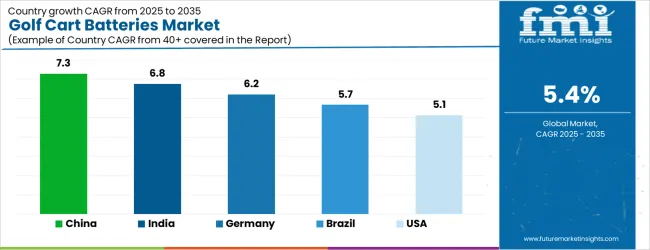
| Country | CAGR |
|---|---|
| China | 7.3% |
| India | 6.8% |
| Germany | 6.2% |
| Brazil | 5.7% |
| USA | 5.1% |
| UK | 4.6% |
| Japan | 4.1% |
<p>The Golf Cart Batteries Market is expected to register a CAGR of 5.4% during the forecast period, exhibiting varied country level momentum. China leads with the highest CAGR of 7.3%, followed by India at 6.8%. Developed markets such as Germany, France, and the UK continue to expand steadily, while the USA is likely to grow at consistent rates. Japan posts the lowest CAGR at 4.1%, yet still underscores a broadly positive trajectory for the global Golf Cart Batteries Market. In 2024, Germany held a dominant revenue in the Western Europe market and is expected to grow with a CAGR of 6.2%. The USA Golf Cart Batteries Market is estimated to be valued at USD 58.4 billion in 2025 and is anticipated to reach a valuation of USD 58.4 billion by 2035. Sales are projected to rise at a CAGR of 0.0% over the forecast period between 2025 and 2035. While Japan and South Korea markets are estimated to be valued at USD 8.1 billion and USD 5.1 billion respectively in 2025.</p>
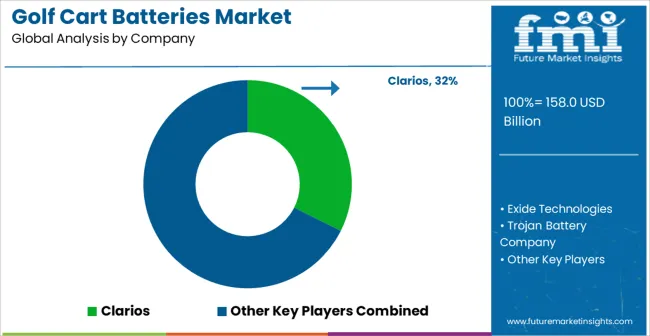
| Item | Value |
|---|---|
| Quantitative Units | USD 158.0 Billion |
| Battery Type | Lead-Acid Batteries and Li-Ion Batteries |
| Drive Type | 36V Electric Drive and 48V Electric Drive |
| Battery Voltage | 12 Volts, 6 Volts, and 8 Volts |
| Seating Capacity | 2 – 4 Seater, 6 – 8 Seater, and 10+ Seater |
| Regions Covered | North America, Europe, Asia-Pacific, Latin America, Middle East & Africa |
| Country Covered | United States, Canada, Germany, France, United Kingdom, China, Japan, India, Brazil, South Africa |
| Key Companies Profiled | Clarios, Exide Technologies, Trojan Battery Company, U.S. Battery Manufacturing, Crown Battery Manufacturing, East Penn Manufacturing, RELiON Batteries, and Leoch International Technology |
The global golf cart batteries market is estimated to be valued at USD 158.0 billion in 2025.
The market size for the golf cart batteries market is projected to reach USD 267.3 billion by 2035.
The golf cart batteries market is expected to grow at a 5.4% CAGR between 2025 and 2035.
The key product types in golf cart batteries market are lead-acid batteries and li-ion batteries.
In terms of drive type, 36v electric drive segment to command 55.0% share in the golf cart batteries market in 2025.






Our Research Products

The "Full Research Suite" delivers actionable market intel, deep dives on markets or technologies, so clients act faster, cut risk, and unlock growth.

The Leaderboard benchmarks and ranks top vendors, classifying them as Established Leaders, Leading Challengers, or Disruptors & Challengers.

Locates where complements amplify value and substitutes erode it, forecasting net impact by horizon

We deliver granular, decision-grade intel: market sizing, 5-year forecasts, pricing, adoption, usage, revenue, and operational KPIs—plus competitor tracking, regulation, and value chains—across 60 countries broadly.

Spot the shifts before they hit your P&L. We track inflection points, adoption curves, pricing moves, and ecosystem plays to show where demand is heading, why it is changing, and what to do next across high-growth markets and disruptive tech

Real-time reads of user behavior. We track shifting priorities, perceptions of today’s and next-gen services, and provider experience, then pace how fast tech moves from trial to adoption, blending buyer, consumer, and channel inputs with social signals (#WhySwitch, #UX).

Partner with our analyst team to build a custom report designed around your business priorities. From analysing market trends to assessing competitors or crafting bespoke datasets, we tailor insights to your needs.
Supplier Intelligence
Discovery & Profiling
Capacity & Footprint
Performance & Risk
Compliance & Governance
Commercial Readiness
Who Supplies Whom
Scorecards & Shortlists
Playbooks & Docs
Category Intelligence
Definition & Scope
Demand & Use Cases
Cost Drivers
Market Structure
Supply Chain Map
Trade & Policy
Operating Norms
Deliverables
Buyer Intelligence
Account Basics
Spend & Scope
Procurement Model
Vendor Requirements
Terms & Policies
Entry Strategy
Pain Points & Triggers
Outputs
Pricing Analysis
Benchmarks
Trends
Should-Cost
Indexation
Landed Cost
Commercial Terms
Deliverables
Brand Analysis
Positioning & Value Prop
Share & Presence
Customer Evidence
Go-to-Market
Digital & Reputation
Compliance & Trust
KPIs & Gaps
Outputs
Full Research Suite comprises of:
Market outlook & trends analysis
Interviews & case studies
Strategic recommendations
Vendor profiles & capabilities analysis
5-year forecasts
8 regions and 60+ country-level data splits
Market segment data splits
12 months of continuous data updates
DELIVERED AS:
PDF EXCEL ONLINE
Golf Cart Battery Market Size and Share Forecast Outlook 2025 to 2035
Golf Cart Market Analysis - Size, Share, and Forecast 2025 to 2035
Electric Golf Cart Market Growth – Trends & Forecast 2025 to 2035
GCC Electric Golf Cart Market Outlook – Demand, Growth & Forecast 2025-2035
Japan Electric Golf Cart Market Insights – Demand, Growth & Forecast 2025-2035
ASEAN Electric Golf Cart Market Trends – Size, Share & Forecast 2025-2035
Germany Electric Golf Cart Market Insights – Trends, Demand & Growth 2025–2035
United States Electric Golf Cart Market Trends – Size, Share & Growth 2025–2035
United Kingdom Electric Golf Cart Market Growth – Demand, Trends & Forecast 2025–2035
Golf Course Engineering Service Market Size and Share Forecast Outlook 2025 to 2035
Cartridge Heating Element Market Size and Share Forecast Outlook 2025 to 2035
Golf Shoes Market Size and Share Forecast Outlook 2025 to 2035
Golf Equipment Market Size and Share Forecast Outlook 2025 to 2035
Carton Sealer Machine Market Size and Share Forecast Outlook 2025 to 2035
Golf Ball Picker Robot Market Size and Share Forecast Outlook 2025 to 2035
Carton Liners Market Size and Share Forecast Outlook 2025 to 2035
Golf Course Maintenance Robot Market Size and Share Forecast Outlook 2025 to 2035
Golf Putter Market Size and Share Forecast Outlook 2025 to 2035
Carton Bottle Market Size and Share Forecast Outlook 2025 to 2035
Carton Display Market Size and Share Forecast Outlook 2025 to 2035

Thank you!
You will receive an email from our Business Development Manager. Please be sure to check your SPAM/JUNK folder too.
Chat With
MaRIA